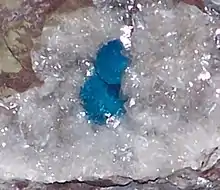Vanadyl ion
The vanadyl or oxovanadium(IV) cation, VO2+,[1] is a functional group that is common in the coordination chemistry of vanadium. Complexes containing this functional group are characteristically blue and paramagnetic. A triple bond is proposed to exist between the V4+ and O2- centers.[2]
2.png.webp)

Natural occurrence
Minerals
Cavansite and pentagonite are vanadyl-containing minerals.
Water
VO2+, often in an ionic pairing with sodium (NaH2VO4), is the second most abundant transition metal in seawater, with its concentration only being exceeded by molybdenum.[3] In the ocean the average concentration is 30 nM. Some mineral water springs also contain the ion in high concentrations. For example, springs near Mount Fuji often contain as much as 54 μg per liter.[3]
Vanadyl-containing compounds
- vanadyl acetylacetonate, VO(acac)2
- vanadyl nitrate, VO(NO3)3[4]
- vanadyl sulfate pentahydrate, VOSO4·5H2O
Related species
References
Greenwood, Norman N.; Earnshaw, Alan (1997). Chemistry of the Elements (2nd ed.). Butterworth-Heinemann. ISBN 978-0-08-037941-8.
- Bertrand, Gary L.; Stapleton, George W.; Wulff, Clause A.; Hepler, Loren G. (July 1966). "Thermochemistry of Aqueous Pervanadyl and Vanadyl Ions". Inorg. Chem. 5 (7): 1283–1284. doi:10.1021/ic50041a048.
- Gray, H. B.; Winkler, J. R. (2018). "Living with Oxygen". Accounts of Chemical Research. 51 (8): 1850–1857. doi:10.1021/acs.accounts.8b00245. PMC 6106048. PMID 30016077.CS1 maint: uses authors parameter (link)
- Rehder, Dieter (2008). Bioinorganic Vanadium Chemistry. Inorganic Chemistry (1st ed.). Hamburg, Germany: John Wiley & Sons, Ltd. pp. 5 & 9–10. doi:10.1002/9780470994429. ISBN 9780470065099.
- Varetti, E.L.; Brandán, S.A.; Ben Altabef, A. (April 1995). "Vibrational and electronic spectra of vanadyl nitrate, VO(NO3)3". Spectrochimica Acta Part A: Molecular and Biomolecular Spectroscopy. 51 (4): 669–675. Bibcode:1995AcSpA..51..669B. doi:10.1016/0584-8539(94)00154-4.
- Satyanarayan, Pal; Kasiraman, Rinku Radhika (July 2001). "Mononuclear Pervanadyl (VO+
2) Complexes with Tridentate Schiff Bases: Self-assembling via C–H…oxo and π-π Interactions". Zeitschrift für Anorganische und Allgemeine Chemie. 627 (7): 1631–1637. doi:10.1002/1521-3749(200107)627:7<1631::AID-ZAAC1631>3.0.CO;2-H.